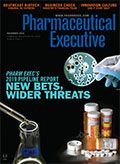Stunted Innovation in Drug Development?
Pharmaceutical Executive
Data shows cultural gaps and highlights a C-level fix.
Most pharma leaders view innovation as vital to improving the drug development process in the US. Yet new data shows the disconnect between the culture of innovation that pharma professionals ascribe to their organizations, and the reality.
To understand perceptions in the industry toward innovation, InCrowd asked 128 pharma executives-representing all major areas from discovery to launch-how they and their respective organizations view innovation.
Part of corporate culture
We found that the majority reported an innovation culture that was strong. Fifty-five percent of respondents report that their internal teams test new technologies that may expedite drug development at least once per quarter. An even larger group-over 70%-agree that their company encourages the exploration and testing of new technologies, often with a sense of urgency.
Despite such encouragement, perceived risks loom. Among total respondents, 30% agreed that exploring new technologies may be too risky or may damage their or their colleagues’ careers if implementation failed. Risk concerns were even higher among specific areas.
- Though 90% of respondents who work in commercialization say that their culture encourages them to explore innovations, nearly 40% say those on their team are afraid that it will hurt their careers if team members try something new and it doesn’t go well.
- Figures were similar among regulatory team respondents: 75% said their culture encourages trying innovations, yet 50% were afraid doing so would hurt their careers.
- Thirty-one percent in drug discovery said there are too many risks with new technologies and innovation-even if there are examples that work.
On perceived barriers to innovation, a resounding 80% of respondents mentioned budget, with less than a third reporting sufficient budget to fund the testing of new innovations in their departments. Also cited was internal inertia with processes, management, and culture, as well as accessibility issues.
Ideas for improvements
What’s going on here, and what are steps C-level leaders can take to address this innovation gap? Respondents named several areas where friction could be removed from the process, especially innovations in data processing.
- Fifty-three percent listed advanced analytics tools, including bioinformatics and artificial intelligence, as high-impact innovation.
- An additional 19% suggest improved computational modeling for PK/PD and toxicity.
- Others noted advances in assay development (21%), preclinical validation (20%), and drug discovery (16%).
Respondents also cited a number of other technologies that could help them.
1. Improved patient recruitment and retention: Advancement in genomic testing for patient selection, digitization of trials, and mobile monitoring.
2. Enhanced system integration: Oversight of data reporting, information archiving, source data analysis, data verification, and access to tumor biobanks.
3. Better analytics capability: Extrapolation of early phase results to larger populations, quality-of-life surveys, data mining, storage, and retrieval.
4. Process enablement: Library prep, expanding online processes for regulatory submissions, and adaptive clinical trials.
The onus is on C-level management to do what is uniquely in its purview-mitigate the anxiety associated with innovating by finding ways to reward teams for trying new technology regardless of the outcome.
When pharma executives encourage the testing of new approaches that are known to be safe and applicable in R&D-and reward these efforts, even when they learn the innovation was not the best solution-they are furthering the movement to shorten drug delivery cycles.
The impact of even incremental innovation can be profound. Shaving even one week off of the $2.6 billion, decade-long process to bring a drug to market could save a manufacturer $500,000. With an earlier launch, companies also lengthen the patent-exclusivity period, garnering them more revenue than planned. Beyond the financial impact is another benefit: more patients receiving their potentially life-changing medicine.

Meghan Oates-Zalesky is senior vice president of marketing at InCrowd

Addressing Disparities in Psoriasis Trials: Takeda's Strategies for Inclusivity in Clinical Research
April 14th 2025LaShell Robinson, Head of Global Feasibility and Trial Equity at Takeda, speaks about the company's strategies to engage patients in underrepresented populations in its phase III psoriasis trials.
Key Findings of the NIAGARA and HIMALAYA Trials
November 8th 2024In this episode of the Pharmaceutical Executive podcast, Shubh Goel, head of immuno-oncology, gastrointestinal tumors, US oncology business unit, AstraZeneca, discusses the findings of the NIAGARA trial in bladder cancer and the significance of the five-year overall survival data from the HIMALAYA trial, particularly the long-term efficacy of the STRIDE regimen for unresectable liver cancer.
Expanding Immune Response Testing to Support Vaccine Development
April 22nd 2025Nigel McCracken, chief operating officer, Virax Biolabs, discusses the expansion of its ViraxImmune platform into areas such as transplant monitoring, vaccine efficacy, latent virus reactivation, and CAR T cell therapy.